Publications
publications by categories in reversed chronological order. generated by jekyll-scholar.
2025
-
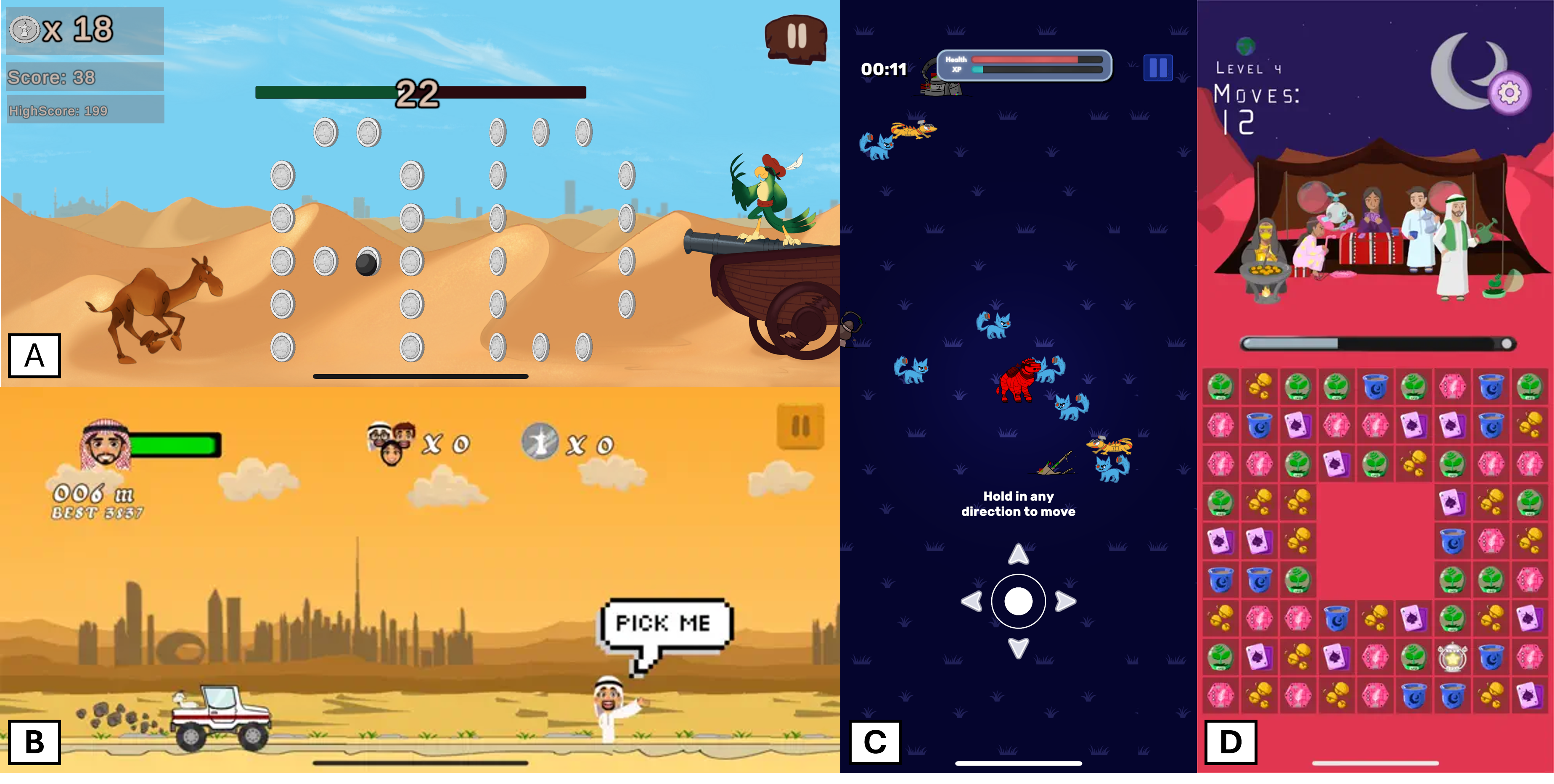 Bridging Cultural Representation and Game Making: Analyzing the Experiences, Outcomes, and Lessons of Early-Stage Game Developers in a Professional Development ProgramMax Chen and Gillian SmithProceedings of the ACM on Human-Computer Interaction, Oct 2025
Bridging Cultural Representation and Game Making: Analyzing the Experiences, Outcomes, and Lessons of Early-Stage Game Developers in a Professional Development ProgramMax Chen and Gillian SmithProceedings of the ACM on Human-Computer Interaction, Oct 2025As the game industry expands, an increasing number of students and hobbyists are entering the game development field, eager to create their own titles. However, there is a lack of structured training programs that effectively prepare them for industry demands. Games convey meaningful messages through stories, assets, and mechanics, yet how early-stage developers make creative decisions while building production skills remains unclear. We explored skill development and cultural representation in game design during a 10-week professional development program at MassDigi with early-stage developers from the United Arab Emirates (UAE). Our findings reveal three observed strategies as themes through which developers incorporate their personal experiences and cultural backgrounds into game development to achieve cultural representation, as well as four themes that address developers’ skill set improvement and personal growth during this process. We recommend structuring programs by considering these themes to enhance self-expressive game design and support skill development through a peer learning community.
@article{chen2025game, author = {Chen, Max and Smith, Gillian}, title = {Bridging Cultural Representation and Game Making: Analyzing the Experiences, Outcomes, and Lessons of Early-Stage Game Developers in a Professional Development Program}, year = {2025}, issue_date = {October 2025}, publisher = {Association for Computing Machinery}, address = {New York, NY, USA}, volume = {9}, number = {6}, url = {https://doi.org/10.1145/3748627}, doi = {10.1145/3748627}, journal = {Proceedings of the ACM on Human-Computer Interaction}, month = oct, articleno = {GAMES032}, numpages = {31}, keywords = {cultural representation, game design, game development education, professional development program, situated learning}, } -
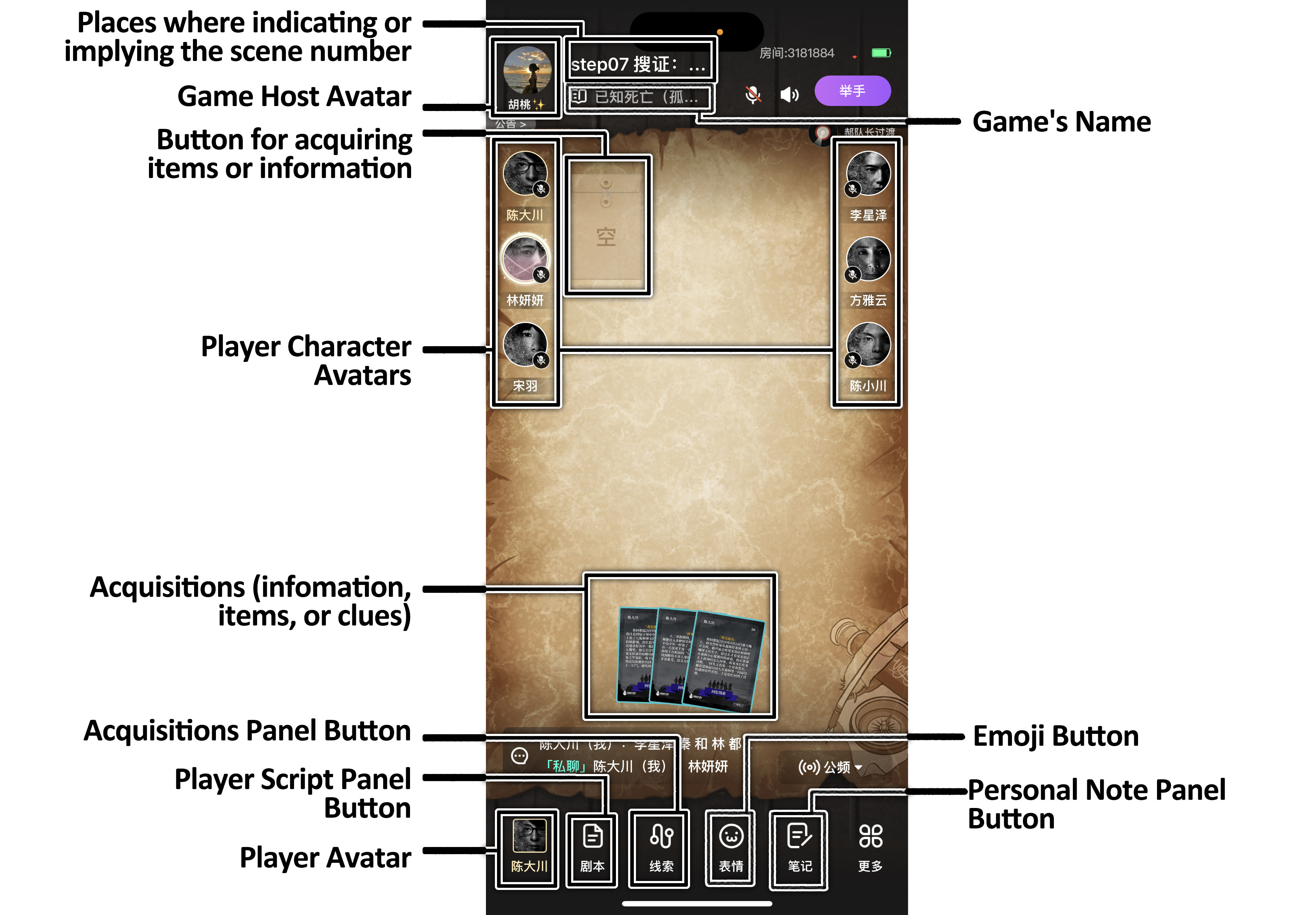 The Collaborative Sensemaking Play of Jubensha Games: A Deconstruction, Taxonomy, and AnalysisShano Liang, Max Chen, Phoebe O. Toups Dugas, Gillian Smith, and Rose BohrerACM Games, Mar 2025
The Collaborative Sensemaking Play of Jubensha Games: A Deconstruction, Taxonomy, and AnalysisShano Liang, Max Chen, Phoebe O. Toups Dugas, Gillian Smith, and Rose BohrerACM Games, Mar 2025Jubensha games, popular in China, combine storytelling, social deduction, and script-centered group play, sparking widespread interest among gamers and researchers worldwide. However, enthusiasts and researchers have struggled to accurately describe Jubensha, often defaulting to comparisons with genres like murder mystery and live-action role-playing games. This reliance on comparisons hinders efforts to generalize Jubensha or to deconstruct and adapt its unique design components, dynamics of player interaction, and playing experience into other games. This research provides a taxonomy and analysis of Jubensha games, based on a thematic analysis of over 80 Jubensha games accessed through mobile applications and physical copies. The analysis combines the authors’ positionalities as native Chinese and English speakers and lenses from close reading of the games, discourse analysis, and distributed cognition. We provide summative case studies to exemplify our taxonomy and discuss design implications for Jubensha games for future projects. Our work provides a descriptive tool and vocabulary for researchers and designers to facilitate communication and theorize the evolving Jubensha gaming phenomenon highlighting how gameplay centers collaborative sensemaking. In addition, we argue that the design of game narratives in Jubensha games, including structures in scripts and the evolving performance of players, can be generalized and transferred to the design of a wider range of analog and video games.
@article{liang2025collaborative, author = {Liang, Shano and Chen, Max and Toups Dugas, Phoebe O. and Smith, Gillian and Bohrer, Rose}, title = {The Collaborative Sensemaking Play of Jubensha Games: A Deconstruction, Taxonomy, and Analysis}, year = {2025}, issue_date = {March 2025}, publisher = {Association for Computing Machinery}, address = {New York, NY, USA}, volume = {3}, number = {1}, url = {https://doi.org/10.1145/3721121}, doi = {10.1145/3721121}, journal = {ACM Games}, month = mar, articleno = {6}, numpages = {34}, keywords = {Jubensha, murder mystery games, taxonomy, game analysis, game design, cross-cultural context}, } -
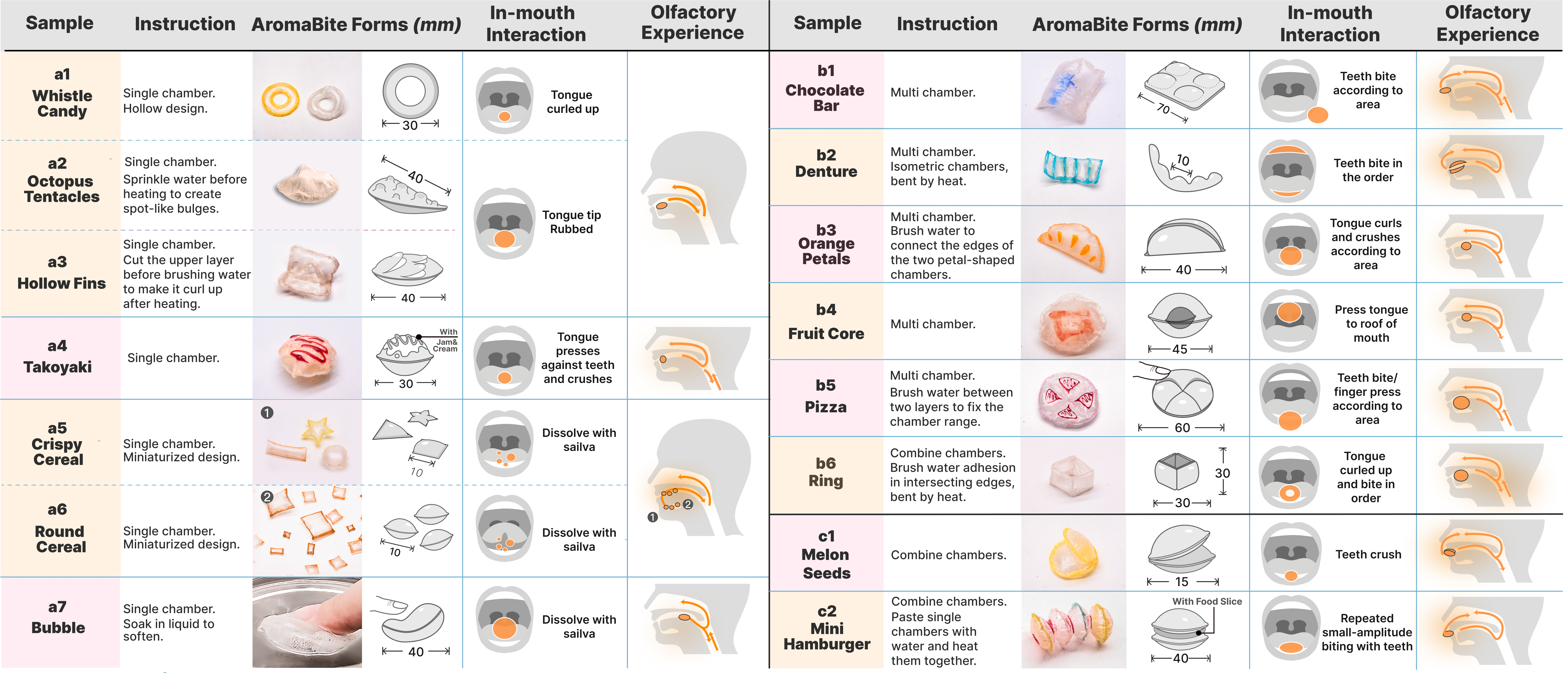 AromaBite: Augmenting Flavor Experiences Through Edible Retronasal Scent ReleaseYucheng Li, Yanan Wang, Mengyuan Xiong, Max Chen, Yifan Yan, and 3 more authorsIn Proceedings of the Extended Abstracts of the CHI Conference on Human Factors in Computing Systems, Yokohama, Japan, Mar 2025
AromaBite: Augmenting Flavor Experiences Through Edible Retronasal Scent ReleaseYucheng Li, Yanan Wang, Mengyuan Xiong, Max Chen, Yifan Yan, and 3 more authorsIn Proceedings of the Extended Abstracts of the CHI Conference on Human Factors in Computing Systems, Yokohama, Japan, Mar 2025Compared to the five basic tastes, smell, as an intrinsic element, is crucial in augmenting flavor and dietary experience within Human-Food Interaction. While much research has explored orthonasal olfaction in olfactory displays, the potential of retronasal olfaction in interaction design is always overlooked and less understood. This paper introduces AromaBite, an accessible, edible, bio-compatible and ingestible odor storage and release mechanism that integrates natural eating behaviors, providing dynamic retronasal olfactory experiences. We detail AromaBite’s design parameters and process and technically test its airtightness and durability. We employ time-intensity (TI), confirming that retronasal olfaction significantly enhances flavor perception and providing a design library mapping form factors to guide natural oral interaction. We envision that AromaBite will augment depth and immersive flavor experiences in Virtual Reality, olfactory training, and personalized dining interactions.
@inproceedings{li2025aromabite, author = {Li, Yucheng and Wang, Yanan and Xiong, Mengyuan and Chen, Max and Yan, Yifan and Li, Junxian and Wang, Qi and Hansen, Preben}, title = {AromaBite: Augmenting Flavor Experiences Through Edible Retronasal Scent Release}, year = {2025}, isbn = {9798400713958}, publisher = {Association for Computing Machinery}, address = {New York, NY, USA}, url = {https://doi.org/10.1145/3706599.3720200}, doi = {10.1145/3706599.3720200}, booktitle = {Proceedings of the Extended Abstracts of the CHI Conference on Human Factors in Computing Systems}, articleno = {76}, numpages = {8}, keywords = {Flavor Augmentation, Retronasal Olfaction, Human-Food Interaction, Scent Releasing, Natural interactivity, Edibles}, location = {Yokohama, Japan}, series = {CHI EA '25} } - Exploring the Purpose and Development of Academic Games: An Analysis of Games Reported at the Foundations of Digital Games Conference (2007–2024)Max Chen and Edward MorrellIn Proceedings of the 20th International Conference on the Foundations of Digital Games, Vienna & Graz, Austria, Mar 2025
One of the more exploratory and experimental forms of output in the games research community involves authors utilising games they have developed in the academic context. Whether fully embodying the role of a designer-researcher in communicating the development process, or presenting the data that derives from a complete game artefact, academics can use games as an integral part of their research. The academic game making context is distinct from other forms of game creation, with academia allowing for certain freedoms while also enforcing its own strict constraints. Our understanding of academic games derives from how they have been reported in the literature, as there is limited preservation of these games as playable experiences. For the 20th Foundations of Digital Games (FDG) conference, we analysed its corpus of 1,437 articles to take examine their historical development and identify some of the developmental trends of academic games as reported over nearly two decades. Through this study, we identify the diverse purposes of these games and examine how they have contributed to advancing research efforts.
@inproceedings{chen2025exploring, author = {Chen, Max and Morrell, Edward}, title = {Exploring the Purpose and Development of Academic Games: An Analysis of Games Reported at the Foundations of Digital Games Conference (2007–2024)}, year = {2025}, isbn = {9798400718564}, publisher = {Association for Computing Machinery}, address = {New York, NY, USA}, url = {https://doi.org/10.1145/3723498.3723823}, doi = {10.1145/3723498.3723823}, booktitle = {Proceedings of the 20th International Conference on the Foundations of Digital Games}, articleno = {39}, numpages = {11}, keywords = {academic games, applied games, game design, game development, foundations of digital games}, location = {Vienna & Graz, Austria}, series = {FDG '25}, }
2024
-
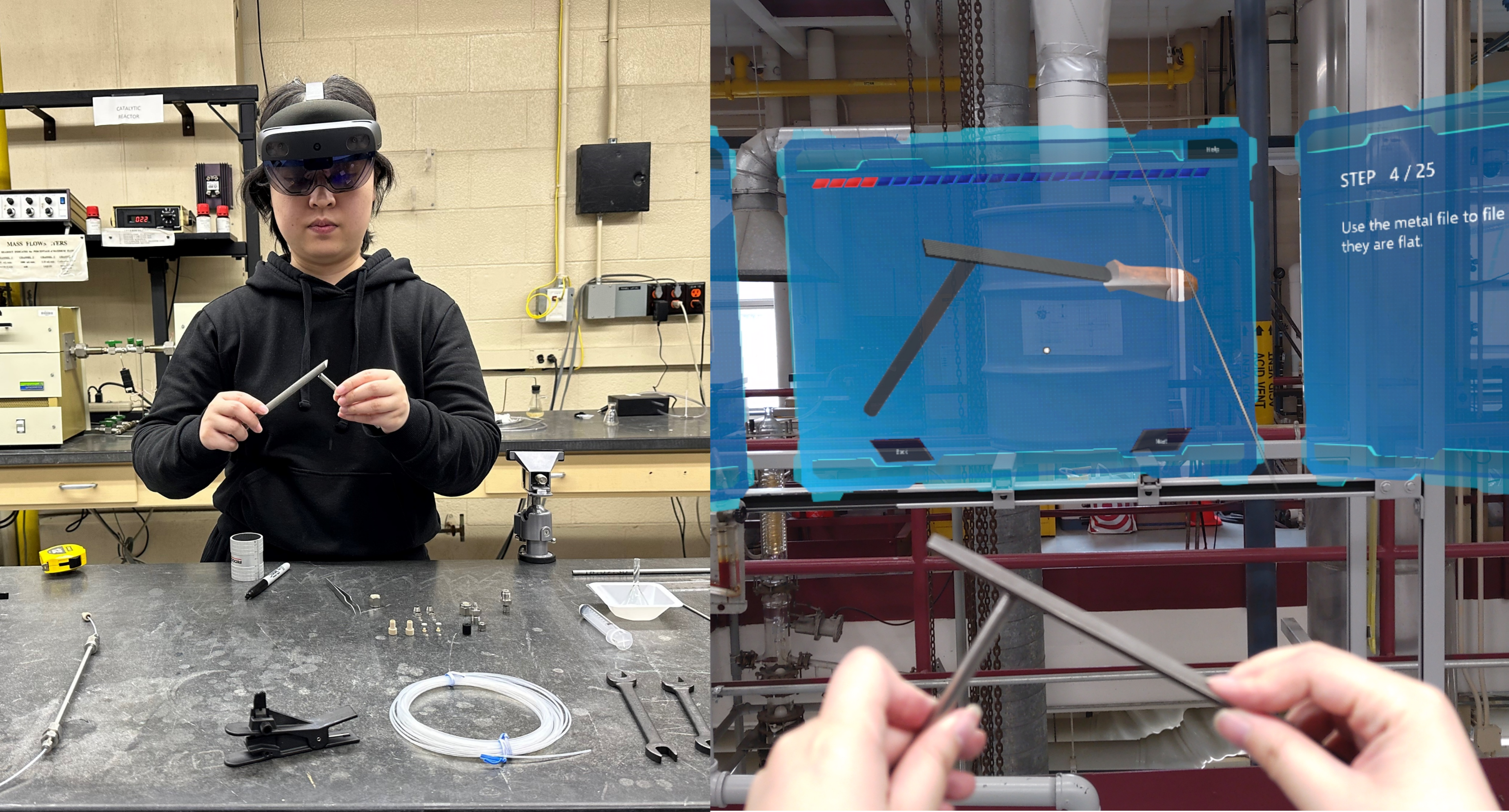 FlowAR: A Mixed Reality Program to Introduce Continuous Flow ConceptsMax Chen, Yichen Li, Hilson Shrestha, Noëlle Rakotondravony, Andrew Teixeira, and 2 more authorsJournal of Chemical Education, Mar 2024
FlowAR: A Mixed Reality Program to Introduce Continuous Flow ConceptsMax Chen, Yichen Li, Hilson Shrestha, Noëlle Rakotondravony, Andrew Teixeira, and 2 more authorsJournal of Chemical Education, Mar 2024Industrial and academic laboratories are undergoing a paradigm shift in process technology from batch to modular flow. Implementation of modular flow processes can enable more efficient operation with superior throughput, scalability, and safety factors owing to superior transport and reaction kinetics. However, both fine chemical and pharmaceutical industries have historically run exclusively batch processes, highlighting a substantive knowledge gap in industrial workforce training in designing and building modular flow systems. To address this gap in knowledge, we developed an augmented reality (AR) program, FlowAR, that aims to teach users how to build modular flow packed bed reactors. FlowAR is a voice-activated program in which users assemble physical objects to build the modular flow reactor that are observed in the FlowAR program with accompanying narration of each step. To compare the learning experience and effectiveness of FlowAR when compared to traditional assembly methods, 34 participants were randomly assigned to AR (experimental) and non-AR (control, i.e., written instructions) conditions to learn and assemble a flow chemistry packed bed column. We obtained pre- and post-questionnaires from the participants with quantitative and qualitative questions on their learning experience. Inspection of the data from our assessments revealed that users in the experimental condition recall the procedure and parts at a higher level when compared to the control condition. In addition, FlowAR resulted in more content clarity and a much more enjoyable and effective experience compared to the control conditions. This provides evidence that voice-activated AR programs can be used to enable students to better assemble complex instruments in an asynchronous format.
@article{chen2024flowar, author = {Chen, Max and Li, Yichen and Shrestha, Hilson and Rakotondravony, Noëlle and Teixeira, Andrew and Harrison, Lane and Dempski, Robert E.}, title = {FlowAR: A Mixed Reality Program to Introduce Continuous Flow Concepts}, journal = {Journal of Chemical Education}, volume = {101}, number = {5}, pages = {1865-1874}, year = {2024}, doi = {10.1021/acs.jchemed.3c00807}, url = {https://doi.org/10.1021/acs.jchemed.3c00807}, eprint = {https://doi.org/10.1021/acs.jchemed.3c00807}, publisher = {ACS Publications}, } - Game Development as Project-Based Learning: Synthesizing Postmortems of Student-Created Mobile GamesMax Chen and Gillian SmithIn Proceedings of the 19th International Conference on the Foundations of Digital Games, Worcester, MA, USA, Mar 2024
Game companies and degree-granting colleges with game design programs create numerous games annually, with lessons learned from the development process holding significance for developers and game developer communities. Usually, game developers write postmortems to reflect on what went right and wrong in their game development process. Existing studies on video game postmortems have been primarily of games from professional studios that take years of development effort. Our work analyzes 36 student-created game postmortems spanning 9 years, all for mobile games shipped after 3-month development cycles in a summer internship program organized by the Massachusetts Digital Games Institute (MassDigi). We identify common themes and topics in these student postmortems and contribute to a greater understanding of student game-creation practices and project-based learning for game education.
@inproceedings{chen2024game, author = {Chen, Max and Smith, Gillian}, title = {Game Development as Project-Based Learning: Synthesizing Postmortems of Student-Created Mobile Games}, year = {2024}, isbn = {9798400709555}, publisher = {Association for Computing Machinery}, address = {New York, NY, USA}, url = {https://doi.org/10.1145/3649921.3649999}, doi = {10.1145/3649921.3649999}, booktitle = {Proceedings of the 19th International Conference on the Foundations of Digital Games}, articleno = {38}, numpages = {11}, keywords = {game development, mobile games, postmortems, professional development program, project-based learning, student games}, location = {Worcester, MA, USA}, series = {FDG '24}, } -
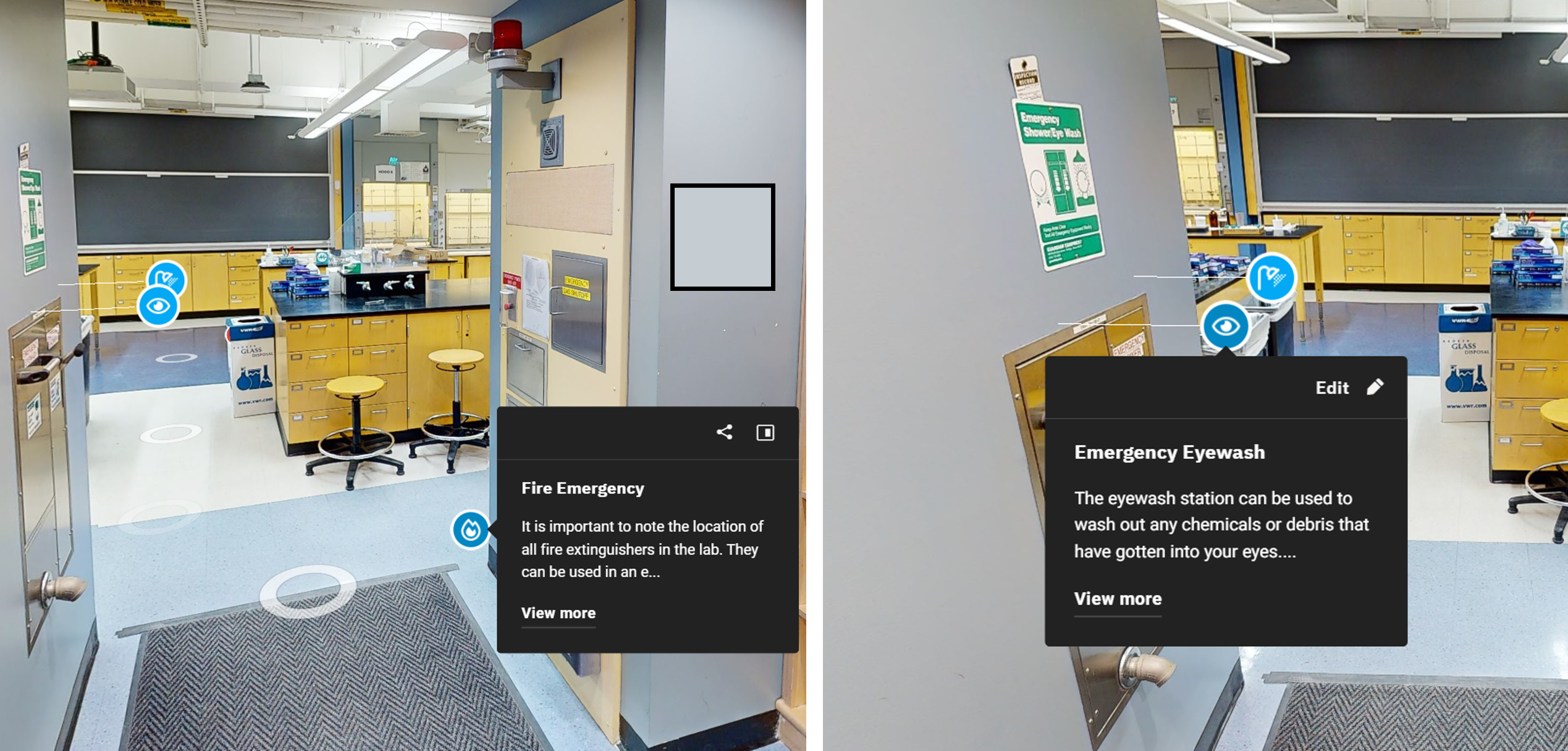 Designing Interactive Virtual Tours for Education: Two Case Studies on Virtual Tours of the Chemistry and Biochemistry LaboratoriesMax Chen, Dashiell Elliott, Robert Dempski, and Raúl Orduña PicónIn Proceedings of the 19th International Conference on the Foundations of Digital Games, Worcester, MA, USA, Mar 2024
Designing Interactive Virtual Tours for Education: Two Case Studies on Virtual Tours of the Chemistry and Biochemistry LaboratoriesMax Chen, Dashiell Elliott, Robert Dempski, and Raúl Orduña PicónIn Proceedings of the 19th International Conference on the Foundations of Digital Games, Worcester, MA, USA, Mar 2024The demand for remote learning and virtual tours increased significantly during the COVID-19 pandemic. While virtual reality training simulations and digital twins have been used in educational settings for a long time, user-friendly methods of designing effective simulations and digital twins have been less studied. Our study adopts the research through design (RtD) framework and the virtual tours iterative development model (VT-IDM) to explore the possibilities and challenges in designing and creating virtual tours for laboratories. In this paper, we present two case studies on virtual tours built with the Matterport platform in the chemistry and biochemistry laboratories to demonstrate how to enact the discovering and designing phases from the first iterative cycle within VR-IDM. Further, we provide a discussion on adopting game design concepts in our design principles. Our work contributes to using and adapting off-the-shelf technology for developing evidence-based serious games for educational purposes.
@inproceedings{chen2024designing, author = {Chen, Max and Elliott, Dashiell and Dempski, Robert and Ordu\~{n}a Pic\'{o}n, Ra\'{u}l}, title = {Designing Interactive Virtual Tours for Education: Two Case Studies on Virtual Tours of the Chemistry and Biochemistry Laboratories}, year = {2024}, isbn = {9798400709555}, publisher = {Association for Computing Machinery}, address = {New York, NY, USA}, url = {https://doi.org/10.1145/3649921.3656982}, doi = {10.1145/3649921.3656982}, booktitle = {Proceedings of the 19th International Conference on the Foundations of Digital Games}, articleno = {50}, numpages = {4}, keywords = {iterative design, research through design (RtD), safety training, serious games, virtual reality, virtual tour}, location = {Worcester, MA, USA}, series = {FDG '24} } - Examining the Trajectory of Early Professionals’ use of Generative AI in the Game Development Process from 2023 to 2024Josiah Boucher, Max Chen, Gillian Smith, and Yunus Doğan TellielIn AIIDE Workshop on Experimental AI in Games, Mar 2024
This paper describes an in-progress examination of the differences in observed perceptions and usability of generative AI (GAI) in MassDigi’s Summer Innovation Program (SIP) from 2023 to 2024. SIP is a professional development program where teams of interns create mobile games in the Unity game engine over an 11-week period. Following a previous study using ethnographic methods to examine this topic in summer 2023, a similar study conducted in summer 2024 found dramatically different results. Where previously, interns broadly resisted the adoption of methods that incorporated GAI, the 2024 cohort was found to embrace the tools. This paper presents the differences in findings, explores possible explanations for these differences, and presents potential paths of research to further investigate the trajectory of GAI adoption amongst creative professionals. We also present four variables that may influence GAI adoption: experience, cultural context, proportion of artists within a community, and shifting societal paradigms.
@inproceedings{boucher2024examining, title = {Examining the Trajectory of Early Professionals’ use of Generative AI in the Game Development Process from 2023 to 2024}, author = {Boucher, Josiah and Chen, Max and Smith, Gillian and Telliel, Yunus Do{\u{g}}an}, year = {2024}, booktitle = {AIIDE Workshop on Experimental AI in Games}, }
2023
-
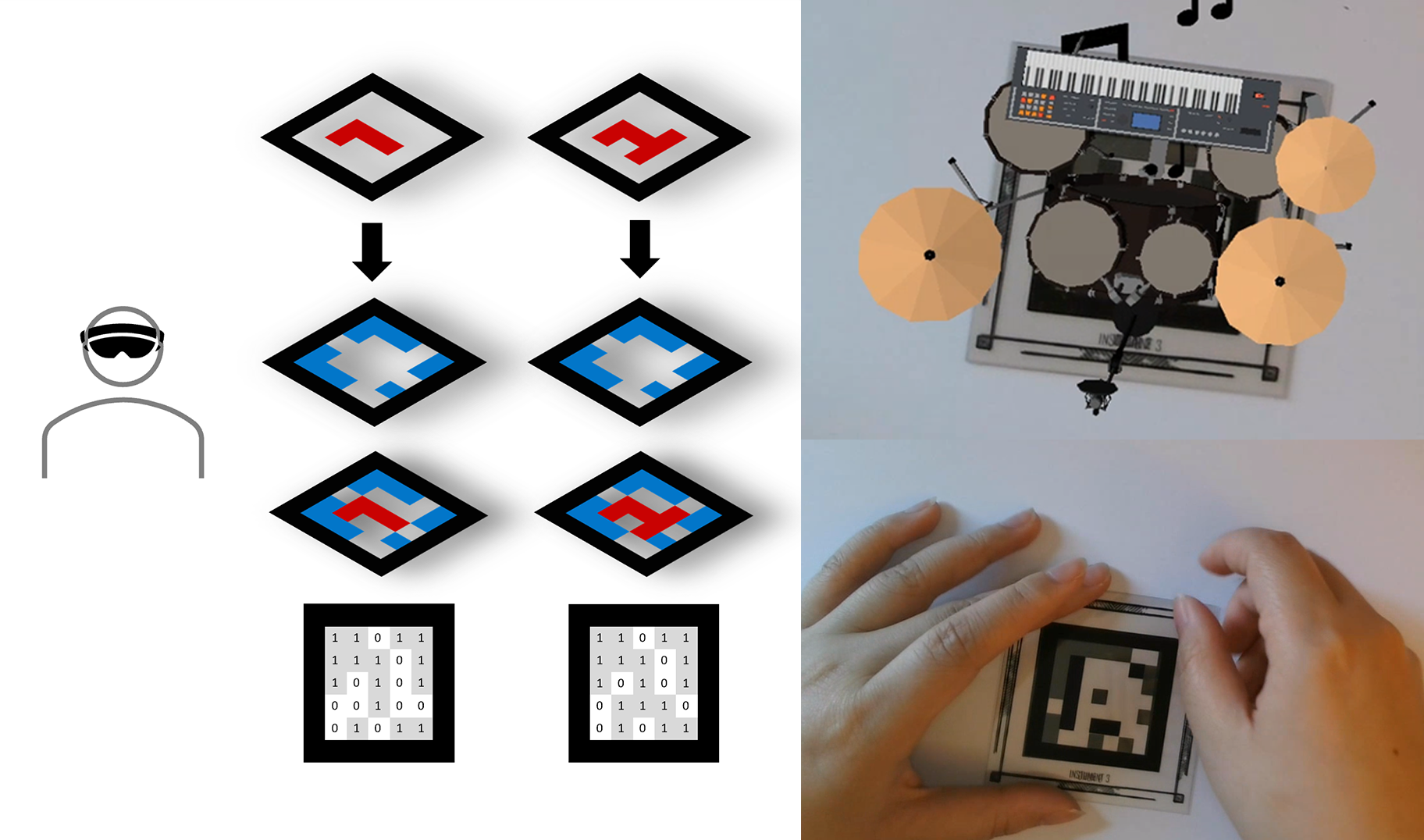 Stackable Music: A Marker-Based Augmented Reality Music Synthesis GameMax Chen, Shano Liang, and Gillian SmithIn Companion Proceedings of the Annual Symposium on Computer-Human Interaction in Play, Stratford, ON, Canada, Mar 2023
Stackable Music: A Marker-Based Augmented Reality Music Synthesis GameMax Chen, Shano Liang, and Gillian SmithIn Companion Proceedings of the Annual Symposium on Computer-Human Interaction in Play, Stratford, ON, Canada, Mar 2023Augmented reality (AR) allows the rendering of digital content on top of the physical space, which is a promising medium for tangible interaction. Marker-based AR is widely used thanks to its low cost and ease of integration, but the gameful aspect of manipulating the physical AR markers remains understudied. In this paper, we explored the stacking mechanics of transparent AR markers and described the creation of an AR music game called Stackable Music. Stackable Music can be developed, assembled, and set up at the home or office with a printer using several sheets of transparent film and a PC or mobile device with a camera.
@inproceedings{chen2023stackable, author = {Chen, Max and Liang, Shano and Smith, Gillian}, title = {Stackable Music: A Marker-Based Augmented Reality Music Synthesis Game}, year = {2023}, isbn = {9798400700293}, publisher = {Association for Computing Machinery}, address = {New York, NY, USA}, url = {https://doi.org/10.1145/3573382.3616071}, doi = {10.1145/3573382.3616071}, booktitle = {Companion Proceedings of the Annual Symposium on Computer-Human Interaction in Play}, pages = {22–28}, numpages = {7}, keywords = {AR Game, Marker-based AR, Tangible Interaction, Transparent AR Markers}, location = {Stratford, ON, Canada}, series = {CHI PLAY Companion '23} } -
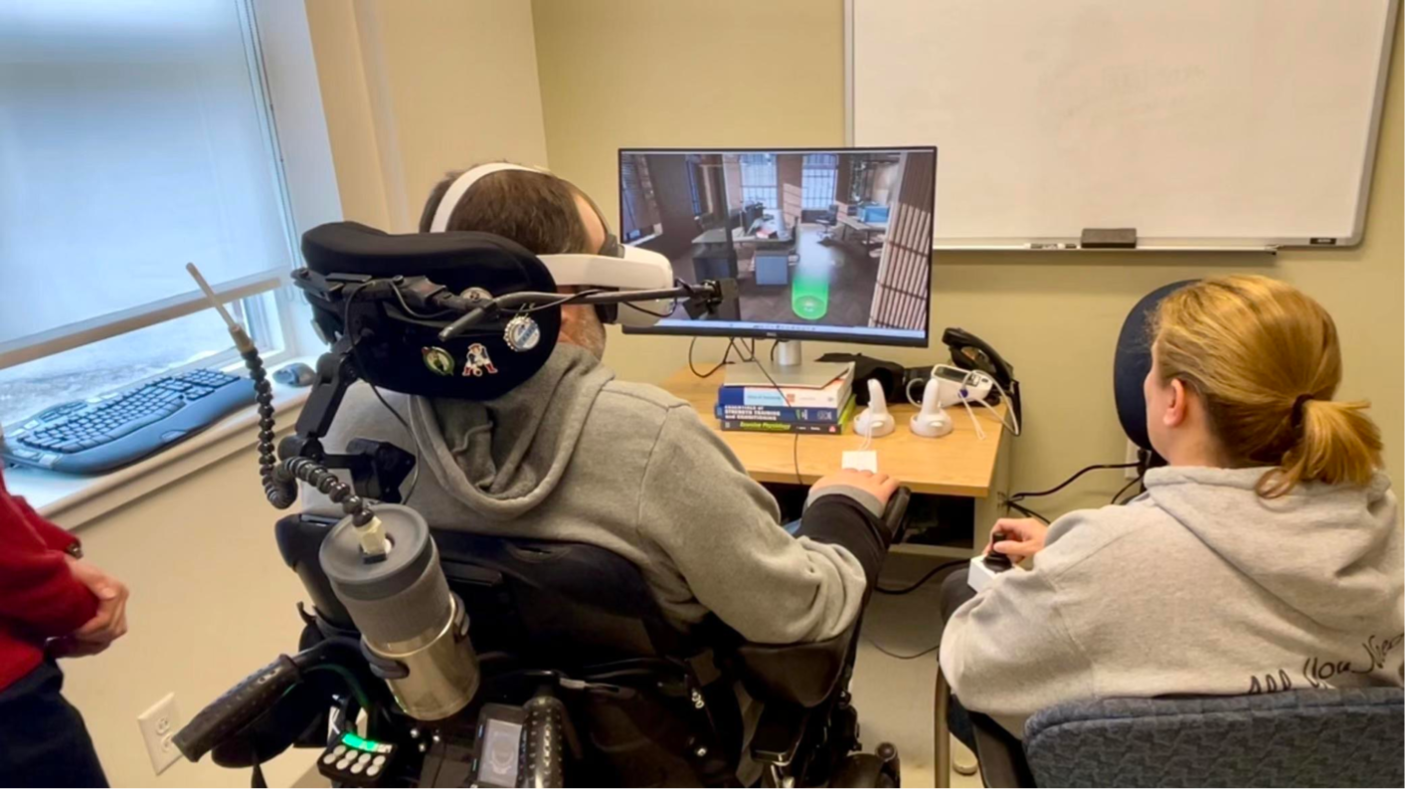 WheelUp! Developing an Interactive Electric-power Wheelchair Virtual Training EnvironmentMax Chen, Yihong Xu, Alexander Sirois, Yichen Li, Robert Dempski, and 5 more authorsIn 2023 IEEE Conference on Games (CoG), Mar 2023
WheelUp! Developing an Interactive Electric-power Wheelchair Virtual Training EnvironmentMax Chen, Yihong Xu, Alexander Sirois, Yichen Li, Robert Dempski, and 5 more authorsIn 2023 IEEE Conference on Games (CoG), Mar 2023Standard power wheelchair training is considered inadequate by clinicians and users due to insufficient means to evaluate user performance in varying environments. Virtual environment training offers a promising alternative by providing users with more practical opportunities while reducing the time demands on clinicians. However, there is a need to further explore and optimize game design elements and strategies to ensure engaging and effective training experiences for a diverse range of users. This paper presents our progress of WheelUp!, an open-source electric wheelchair virtual reality (VR) simulator. The simulator offers modularity for clinician-controlled difficulty adjustment, immediate visual and audio feedback, and a visualization tool to aid in clinical assessment and monitoring of progress. This is the first step to building an interactive platform to address the inadequacy of wheelchair training.
@inproceedings{chen2023wheelup, author = {Chen, Max and Xu, Yihong and Sirois, Alexander and Li, Yichen and Dempski, Robert and Smith, Gillian and Oda, Yuko and Telliel, Yunus and Lewis, Erika S. and Wolkowicz, Kelilah L.}, booktitle = {2023 IEEE Conference on Games (CoG)}, title = {WheelUp! Developing an Interactive Electric-power Wheelchair Virtual Training Environment}, year = {2023}, pages = {1-6}, keywords = {Training;Visualization;Navigation;Wheelchairs;Virtual environments;Games;Tutorials;Power Wheelchair Training;Virtual Reality (VR);Virtual Environment;Training Game}, doi = {10.1109/CoG57401.2023.10333203} } -
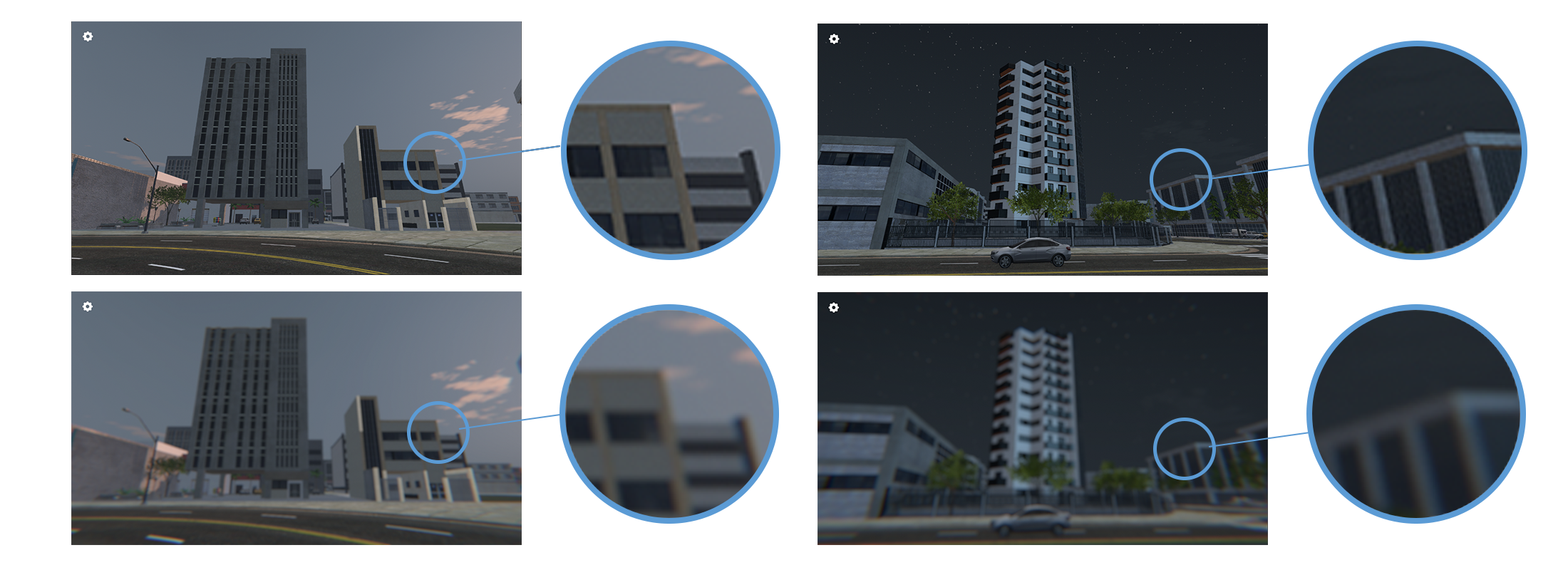 Impact of BCI-Informed Visual Effect Adaptation in a Walking SimulatorMax Chen, Erin Solovey, and Gillian SmithIn Proceedings of the 18th International Conference on the Foundations of Digital Games, Lisbon, Portugal, Mar 2023
Impact of BCI-Informed Visual Effect Adaptation in a Walking SimulatorMax Chen, Erin Solovey, and Gillian SmithIn Proceedings of the 18th International Conference on the Foundations of Digital Games, Lisbon, Portugal, Mar 2023In this paper, we explore the use of brain-computer interface (BCI)-adapted visual effects to support atmosphere in a walking simulator, and investigate its impact on player-reported immersive experience. While players were using a keyboard or joystick controller to control the basic movement of a character, their mental state was accessed by a non-invasive BCI technique called functional near-infrared spectroscopy (fNIRS) to implicitly adjust the visual effects. Specifically, when less brain activity is detected, the players’ in-game vision becomes blurry and distorted, recreating the impression of losing focus. With this biological indication, we designed a BCI-controlled game, in which the vision becomes blurry and distorted when less brain activity is detected, recreating the impression of losing focus. To analyze the player’s experience, we conducted a within-subjects study where participants played both a BCI-controlled and non-BCI-controlled game and completed a questionnaire after each session. We then conducted a semi-structured interview to investigate player perceptions of the impact the BCI had on their experiences. The results showed that players had slightly improved immersion in the BCI-adaptive game, with the temporal dissociation score significantly different. Players also reported the BCI-adaptive visual effects are realistic and natural, and they enjoyed using BCI as a supplemental control.
@inproceedings{chen2023impact, author = {Chen, Max and Solovey, Erin and Smith, Gillian}, title = {Impact of BCI-Informed Visual Effect Adaptation in a Walking Simulator}, year = {2023}, isbn = {9781450398558}, publisher = {Association for Computing Machinery}, address = {New York, NY, USA}, url = {https://doi.org/10.1145/3582437.3582448}, doi = {10.1145/3582437.3582448}, booktitle = {Proceedings of the 18th International Conference on the Foundations of Digital Games}, articleno = {5}, numpages = {8}, keywords = {BCI, Immersive Experience, Personalized Experience, Visual Effect, Walking Simulator, fNIRS}, location = {Lisbon, Portugal}, series = {FDG '23}, }
2022
- Converting natural language policy article into MBSE modelMax Chen and Shamsnaz Virani BhadaIn INCOSE International Symposium, Mar 2022
System Engineers work on designing human interfaces for easy access to governance and technology. As we move to digital engineering, the policy documents are still written in natural language that sometimes is obscure and verbose. One way of digitizing is to convert natural language policies into machine readable system engineering models. In the past, converting natural language written policy documents into machine readable models involves great human effort and expert knowledge in relevant domains, which is a time consuming, tedious, and sometimes impossible task. Artificial Intelligence and its application have shown the potential to accelerate the process. In this study, we proposed a natural language processing (NLP)-based framework for information extraction under the general condition that can automatically detect the actors and their responsible actions. To validate the performance of the model developed, we compared the NLP generated report with manually created SysML model. The result shows that the precision and recall rate of extracting roles and responsibility is 0.86 and 0.66, respectively, representing that this text-to-model framework has the potential to accurately convert general policy documents into SysML.
@inproceedings{chen2022converting, title = {Converting natural language policy article into MBSE model}, author = {Chen, Max and Bhada, Shamsnaz Virani}, booktitle = {INCOSE International Symposium}, volume = {32}, pages = {73--81}, year = {2022}, doi = {10.1002/iis2.12897}, organization = {Wiley Online Library} } - Integrating Immersive Learning Tools across Campus and BeyondRobert Dempski, Andrew R Teixeira, Claire Li, Shano Liang, and Max ChenIn AIChE, Mar 2022
Recent developments in technology and learning sciences alongside pandemic era restrictions have provided ample opportunities to develop, implement and assess immersive learning tools for academic and industrial settings. To deploy our AR and VR tools more efficiently across campus and beyond, we created the Intentional Design Studio (IdeaS). IdeaS merges arts, science and engineering disciplines with digital media research and production. IdeaS focuses on value creation through a broad spectrum of digital media products that support and promote faculty research and teaching, scholarship and external partnerships. To do this, IdeaS trains and employs undergraduate and graduate students to support innovative projects using cutting-edge hardware and software technologies in immersive/interactive media tools. At the same time, IdeaS partners with underserved communities to enhance affordable and accessible educational and research opportunities (worldwide training, K-12 outreach, asynchronous learning, connectivity, mental health). Here, we will describe some of our efforts in the areas of laboratory safety, remote instruction and apps designed to improve classroom learning outcomes.
@inproceedings{dempski2022integrating, title = {Integrating Immersive Learning Tools across Campus and Beyond}, author = {Dempski, Robert and Teixeira, Andrew R and Li, Claire and Liang, Shano and Chen, Max}, booktitle = {AIChE}, year = {2022}, }